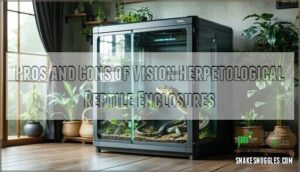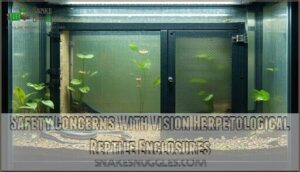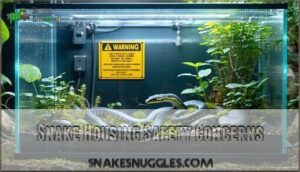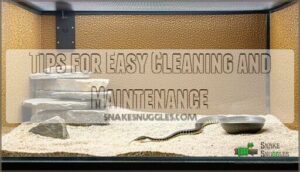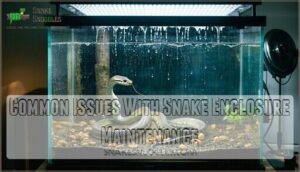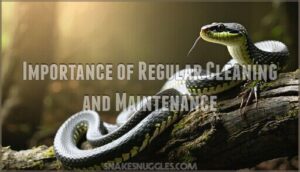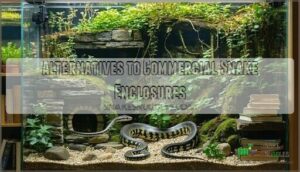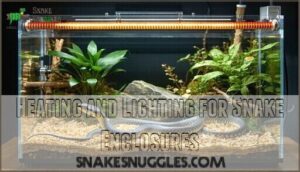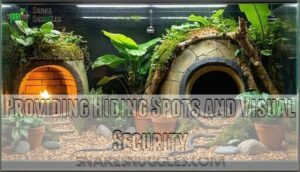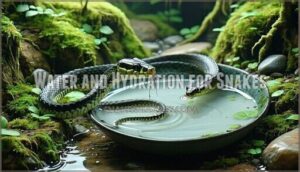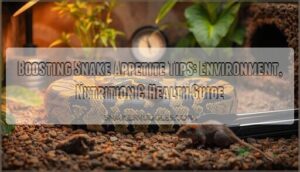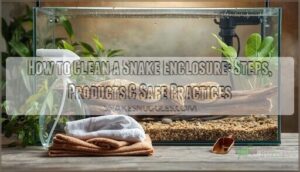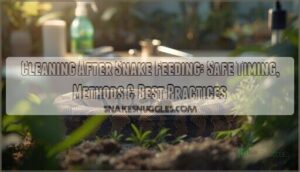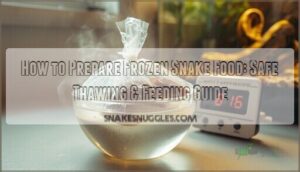This site is supported by our readers. We may earn a commission, at no cost to you, if you purchase through links.

Quality enclosures feature secure locking mechanisms, proper ventilation systems, and materials that won’t harbor bacteria or break down over time.
You’ll want to evaluate escape-proof designs, temperature control capabilities, and easy-access cleaning features.
Glass terrariums, PVC enclosures, and custom-built options each offer distinct advantages depending on your snake’s species and size requirements.
Safety features like rounded corners, secure latches, and adequate spacing between ventilation holes prevent injuries and escapes.
The best enclosures balance your snake’s behavioral needs with your maintenance preferences, creating a secure environment where both of you can thrive.
Table Of Contents
- Key Takeaways
- Choosing The Right Snake Enclosure
- Vision Herpetological Reptile Enclosures Review
- Snake Housing Safety Concerns
- Maintaining and Cleaning Snake Enclosures
- Alternatives to Commercial Snake Enclosures
- Heating and Lighting for Snake Enclosures
- Substrate and Humidity for Snake Enclosures
- Providing Hiding Spots and Visual Security
- Water and Hydration for Snakes
- Tips for Creating a Snake-Friendly Environment
- Frequently Asked Questions (FAQs)
- What is snake housing?
- How do I choose a snake housing?
- How long should a snake house be?
- How do you choose a snake enclosure?
- Do snakes come down to the floor of their enclosures?
- Do snakes need enclosures?
- What not to put in a snake enclosure?
- What type of enclosure is best for snakes?
- Did custom reptile habitats go out of business?
- What is the best housing for a ball python?
- Conclusion
Key Takeaways
- You’ll need escape-proof enclosures with secure locking mechanisms – 73% of snake escapes happen due to inadequate security, so prioritize reinforced seals, tamper-resistant locks, and proper ventilation that won’t compromise containment.
- Choose materials based on your maintenance preferences and your snake’s needs – Glass terrariums offer visibility and easy cleaning, plastic enclosures provide durability, and wooden cages deliver superior insulation for temperature control.
- Size your enclosure to accommodate your snake’s adult length and natural behaviors – You’ll need housing that’s at least two-thirds your snake’s total body length, with proper floor space for movement and thermoregulation.
- Safety features aren’t optional when dealing with venomous or small species – You’ll require specialized protocols for dangerous snakes and hardware cloth over standard mesh for juveniles that can slip through microscopic gaps.
Choosing The Right Snake Enclosure
You’ll need to take into account your snake’s adult size, ventilation requirements, and species-specific needs when selecting an enclosure.
The right housing choice depends on factors like your budget, maintenance preferences, and whether you want glass visibility or wooden insulation.
Factors to Consider for Snake Housing
Your snake’s enclosure size should accommodate their adult length and natural behaviors.
Consider enclosure materials like glass or plastic, proper ventilation systems, and humidity control mechanisms.
Temperature zones create thermal gradients essential for thermoregulation.
Research your species’ specific requirements before purchasing any snake housing or reptile enclosure to guarantee the best health and comfort.
Types of Snake Enclosures Available
When shopping for your snake’s new home, you’ll encounter several enclosure types.
Glass Terrariums offer excellent visibility and easy cleaning but lack insulation.
Plastic Enclosures like Vision Herpetological provide durability yet may bow under weight.
Wooden Cages deliver superior insulation and customization options but require maintenance to prevent mold.
DIY Builds allow complete customization at lower costs, while Custom Enclosures provide personalized solutions for specific species needs.
Safety Features to Look for in Snake Enclosures
Beyond choosing the right enclosure type, you’ll need specific safety features that protect both you and your snake.
Three non-negotiable safety elements include:
- Escape-proof design with seamless construction and substrate shields preventing gap exploitation
- Secure locks featuring emergency releases and snake guards for handler protection
- Ventilation systems maintaining proper airflow while preventing escapes through screened openings
Vision Herpetological Reptile Enclosures Review
You’ll find Vision Herpetological enclosures offer excellent durability and ventilation, though they come with specific considerations you should know about.
These plastic enclosures can experience bowing over time and may have substrate drainage issues that affect long-term maintenance.
Pros and Cons of Vision Herpetological Reptile Enclosures
Vision Herpetological Reptile Enclosures offer impressive durability through high-density polyethylene construction and tempered glass doors.
Looking at the paragraph about Vision Herpetological enclosures, here’s a short, engaging blockquote in the same tone:
**Durable construction meets practical design for serious reptile keepers.
These Enclosure Materials excel at humidity retention and Ventilation Systems control. However, you’ll face higher costs, potential substrate clogging in drainage systems, and limited Customization Options.
The seamless design enhances Reptile Safety while creating ideal Snake Habitat conditions for most species.
The enclosure’s ease of cleaning and humidity retention features make it an ideal choice for reptile owners.
Safety Concerns With Vision Herpetological Reptile Enclosures
Understanding Vision Herpetological Reptile Enclosures means recognizing potential safety pitfalls that could compromise your snake’s security.
The door lip creates hiding spots where venomous species might lurk, posing serious risks during maintenance.
Critical safety concerns include:
- Door gaps – Small snakes can exploit minimal spaces for escape attempts
- Ventilation issues – Poor airflow creates respiratory hazards for your reptile
- Substrate clogging – Blocked drainage systems lead to unsanitary conditions
- Structural bowing – Plastic walls may warp, compromising escapeproof design
You can modify these enclosures by filling voids with expanding foam, ensuring secure locks function properly, and regularly inspecting door safety concerns to maintain proper snake security.
Snake Housing Safety Concerns
When keeping snakes, you’ll face unique safety challenges that vary dramatically between species and enclosure types.
From venomous species requiring specialized protocols to tiny juveniles that can slip through microscopic gaps, understanding these risks protects both you and your serpent, particularly in terms of venomous species.
Venomous Snakes and Safety Precautions
When housing venomous snakes, your safety depends on proper escape prevention and safety gear.
Your venomous snake’s enclosure isn’t just housing—it’s your lifeline against deadly encounters.
These dangerous species require specialized enclosures with secure locks and venom handling protocols.
- Escape-proof design with reinforced seals and tamper-resistant mechanisms
- Safety gear including snake hooks, tongs, and protective clothing for all interactions
- Secure locking systems that prevent accidental openings and unauthorized access
Professional-grade enclosures feature negative pressure systems and durable materials that withstand strikes while protecting against toxic species exposure.
Ensuring proper snake care involves following safety protocols to minimize risks.
Small Snakes and Escape-Proofing
Small snakes turn into escape artists without proper Snake Security.
These miniature masters slip through gaps you’d never expect.
Escape Prevention starts with secure locks and reinforced Ventilation Systems.
Your escapeproof enclosure needs hardware cloth over standard mesh – it’s tighter weave stops even baby corn snakes.
| Small Species | Gap Size Limit | Recommended Lock Type |
|---|---|---|
| Juvenile Ball Python | 1/4 inch | Sliding bolt lock |
| Baby Corn Snake | 1/8 inch | Magnetic latch |
| Young King Snake | 3/16 inch | Keyed cylinder |
| Hatchling Gopher Snake | 1/4 inch | Cam lock |
| Juvenile Milk Snake | 1/8 inch | Spring-loaded clip |
Your snake enclosure reviews should prioritize Cage Locks over fancy features.
Check every seam, joint, and ventilation opening.
A $20 hardware cloth upgrade beats replacing an escaped snake.
Common Safety Issues With Snake Enclosures
Several critical safety issues plague snake enclosures, threatening both keeper and serpent.
Poor ventilation creates stagnant air, while faulty locking mechanisms invite escapes.
Temperature control malfunctions cause thermal stress, and humidity problems trigger respiratory infections.
Inadequate hiding spots stress snakes, compromising their immune systems.
Escapeproof enclosure design prevents disasters—secure snake cage security saves lives.
Maintaining and Cleaning Snake Enclosures
You’ll need to establish a consistent cleaning routine to prevent bacterial growth and maintain your snake’s health.
Regular maintenance involves weekly spot cleaning, substrate replacement, and disinfection with reptile-safe products to guarantee a hygienic environment.
Tips for Easy Cleaning and Maintenance
Keeping your snake’s home spotless doesn’t have to be a chore. Smart cleaning tips and maintenance schedules will keep both you and your snake happy.
Here’s how to streamline your hygiene practices:
- Weekly cleaning routine: Spot-clean waste immediately, then deep-clean the entire enclosure weekly using reptile-safe sanitation methods.
- Smart enclosure design: Choose cages with removable panels and smooth surfaces that won’t trap bacteria or debris.
- Right substrate choice: Use paper towels or reptile carpet instead of loose materials for easier snake cage cleaning.
- Proper ventilation: Verify snake enclosure ventilation prevents moisture buildup that leads to mold and bacterial growth.
Common Issues With Snake Enclosure Maintenance
You’ll face several snake enclosure maintenance challenges that can frustrate even experienced keepers.
Ventilation issues create stagnant air and mold growth, while humidity control problems lead to respiratory infections or shedding difficulties.
Cleaning challenges include substrate clogging door tracks and cage bowing from moisture damage.
Escape prevention requires constant vigilance for warped seals and loose fittings.
Maintenance costs add up quickly when replacing damaged components affects your reptile enclosure maintenance routine.
Importance of Regular Cleaning and Maintenance
Regular snake enclosure maintenance prevents disease outbreaks and extends your setup’s lifespan. Consistent cleaning schedules create healthier environments while proper sanitation methods control bacterial growth. Your snake’s well-being depends on these hygiene practices.
Proper reptile care techniques are essential for maintaining a healthy environment.
Follow these essential maintenance tips:
- Weekly spot cleaning – Remove waste and uneaten food immediately
- Monthly deep disinfection – Use reptile-safe disinfection techniques on all surfaces
- Quarterly substrate replacement – Fresh bedding prevents ammonia buildup
- Bi-annual inspections – Check for wear, damage, or ventilation issues
Alternatives to Commercial Snake Enclosures
You’re not stuck with commercial snake enclosures if they don’t meet your specific needs or budget constraints.
Custom-built cages, converted aquariums, and DIY options can provide better functionality while saving money on your reptile housing investment, which can be a significant budget consideration.
Custom-Built Cages for Snakes
Custom-built cages offer unmatched flexibility for snake housing needs.
You’ll control every aspect of cage design and snake safety through custom materials selection and enclosure security features.
When planning a custom enclosure, considering custom enclosure options is vital for superior snake housing.
| Material Option | Key Benefits |
|---|---|
| PVC/HDPE Panels | Moisture-resistant, durable, easy cleaning |
| Hardwood Frames | Premium strength, natural aesthetics |
| Melamine/Plywood | Cost-effective insulation when sealed |
Build costs vary substantially based on materials and complexity.
A custombuilt cage requires technical skill but delivers superior reptile enclosure performance compared to commercial options in snake cage reviews.
Plan your snake enclosure setup carefully for the best results.
Aquariums as an Alternative to Snake Enclosures
Beyond traditional reptile enclosures, aquarium conversions offer cost-effective snake housing solutions.
Standard fish tanks transform into secure reptile aquariums with proper modifications:
- Ventilation upgrades – Install mesh screens replacing standard lids for airflow
- Substrate selection – Choose appropriate bedding for your snake species
- Security enhancements – Add locks preventing escapes from converted tanks
Aquarium safety depends on proper snake tank ratings and secure fish tank mods for ideal reptile enclosure performance.
DIY Snake Enclosure Options
Building your own snake enclosure gives you complete control over design and materials.
You’ll save money while creating a perfect habitat for your snake’s specific needs.
| Material | Cost Range | Best For |
|---|---|---|
| Plywood | $50-150 | Custom builds, insulation |
| PVC Sheets | $75-200 | Easy cleaning, durability |
| Glass Panels | $100-300 | Visibility, professional look |
DIY enclosures require careful planning for proper ventilation and snake safety.
Budget options using repurposed materials can work, but don’t compromise on security features like escape-proof locks and adequate heating zones.
Heating and Lighting for Snake Enclosures
You’ll need proper thermoregulation systems to keep your snake healthy, as incorrect temperatures can cause serious health issues or even death.
Heat sources like under-tank heaters, ceramic heat emitters, and UVB lighting work together to create the temperature gradient your snake requires for digestion and overall well-being.
Options for Heating Snake Enclosures
Heat Lamps provide targeted warmth, while thermal mats and heat pads offer consistent under-tank heating.
Heating elements create essential temperature gradients from basking to cool zones.
Always use thermostats for precise temperature control – overheating kills snakes faster than cold temperatures.
Ceramic heaters work well for nighttime warmth without disrupting sleep cycles.
Proper heat lamp systems(heat lamp products) are vital for maintaining ideal temperatures in snake enclosures.
Lighting Options for Snake Enclosures
How do you illuminate your snake’s habitat without compromising their health?
Proper lighting supports natural behavior and physiological processes in captive reptiles.
- UVB Lighting – Essential for calcium metabolism and preventing metabolic bone disease in diurnal species
- Heat Lamps – Provide localized warmth while creating natural photoperiods for thermoregulation
- LED Options – Energy-efficient fixtures offering customizable spectrum control for day/night cycles
- Daylight Bulbs – Simulate natural lighting patterns to maintain circadian rhythms
Safety Considerations for Heating and Lighting
When handling heat sources and lighting options, you’ll need proper electrical precautions to prevent fire risks.
Always use thermostats with heat mats and secure all UVB lights away from flammable materials.
Temperature control systems and adequate ventilation are essential for thermal safety.
Never place heating and lighting equipment near water sources.
Properly designed reptile heating systems can help maintain ideal temperatures for snakes.
Substrate and Humidity for Snake Enclosures
You’ll need to select substrate that matches your snake’s natural habitat and burrowing behavior to maintain proper health and comfort.
Maintaining humidity levels between 50-60% for most species prevents respiratory infections and shedding problems that can seriously impact your snake’s wellbeing.
Choosing The Right Substrate for Your Snake
Your substrate choice directly impacts your snake’s health and enclosure maintenance.
Reptile carpet offers easy cleaning and reuse, while paper bedding provides affordable absorption.
Bioactive soil creates naturalistic environments with live microorganisms.
Coconut coir works well for burrowing species, and cypress mulch enhances aesthetics.
Consider your snake’s natural habitat when selecting substrate options for ideal comfort and humidity control.
Maintaining Proper Humidity Levels in Snake Enclosures
Proper humidity control transforms your snake’s health through consistent monitoring and adjustment.
You’ll need these essential tools for ideal snake enclosure humidity:
- Hygrometer Use – Monitor humidity levels daily with digital sensors
- Water Bowls – Position larger bowls over heat sources for natural evaporation
- Misting Systems – Spray dechlorinated water to boost moisture levels
- Ventilation Management – Balance airflow with humidity retention in your reptile enclosure
The essential tools listed are crucial for maintaining the ideal environment for your snake, and by following these guidelines, you can ensure the health and well-being of your pet.
Importance of Humidity and Substrate for Snake Health
Humidity control and substrate choices directly impact your snake’s well-being.
Poor environmental balance causes shedding problems, respiratory infections, and fungal growth.
Monitor humidity control with a hygrometer and choose appropriate substrate options for your species.
Proper snake hydration and health monitoring prevent costly vet visits.
Your reptile enclosure needs consistent moisture levels to maintain a healthy naturalistic environment that supports ideal snake health.
Providing Hiding Spots and Visual Security
Your snake needs secure hiding spots to feel safe and reduce stress levels.
You’ll want to provide both warm-side and cool-side hides using commercial reptile caves, hollow logs, or even overturned flower pots with entrance holes.
Importance of Hiding Spots for Snakes
Your snake needs secure retreats to thrive in captivity. Snake Hides reduce stress levels and promote natural behaviors that keep your pet healthy.
Without adequate hiding spots, snakes experience chronic anxiety that weakens their immune system.
Quality Snake Security options include:
- Commercial reptile caves designed for snake habitat requirements
- Natural rock formations with appropriate crevices for Environmental Enrichment
- Hollow logs that provide Visual Barriers from external disturbances.
These Stress Reduction elements transform your snake enclosure into a comfortable snake vivarium where your pet feels protected and secure.
Options for Providing Visual Security in Snake Enclosures
Beyond simple hiding spots, you’ll want to create visual barriers throughout your snake’s enclosure using strategic enclosure decor.
Plants, rocks, and logs work as natural snake hides while providing visual security.
These security features help your snake feel protected from all angles.
Consider adding branches or artificial foliage to break sight lines within your snake vivarium, creating a more naturalistic enclosure design.
Creating a Stress-Free Environment for Snakes
Your snake’s wellbeing depends on understanding Snake Behavior and recognizing stress signals like defensive posturing or reduced appetite.
Environmental Enrichment through proper Habitat Design creates a stressfree environment that promotes Stress Reduction.
Position your snake enclosure away from high-traffic areas, verify adequate ventilation, and include multiple hiding spots throughout a naturalistic environment for maximum comfort.
Water and Hydration for Snakes
You’ll need to provide fresh, clean water for your snake’s drinking and soaking needs, with water bowls that are shallow enough for easy access but deep enough for full submersion.
Regular water changes and proper bowl placement help maintain ideal hydration levels while preventing bacterial growth that could compromise your snake’s health, which is crucial for proper bowl placement.
Providing Access to Water for Snakes
Water access becomes your next priority after securing hiding spots. Heavy, shallow water bowls prevent tipping while allowing easy access for drinking and occasional soaking.
Position these drinking stations away from heat sources to maintain ideal water quality and prevent rapid evaporation.
- Water bowl size should accommodate your snake’s body width for comfortable soaking during shedding cycles
- Water parameters matter – use dechlorinated or filtered water to avoid harmful chemicals that affect snake hydration
- Water features require cleaning every 3-5 days to prevent bacterial growth and maintain proper humidity control
Maintaining Proper Hydration Levels in Snakes
Proper hydration directly impacts your snake’s health and shedding success. You’ll need to monitor humidity levels between 50-80% depending on your species – ball pythons require higher humidity than corn snakes.
Snake Dehydration shows through wrinkled skin and sunken eyes, while proper Hydration Methods prevent these issues.
Water Quality maintenance keeps your snake healthy:
- Check water parameters daily for cleanliness and temperature
- Replace water every 3-5 days to prevent bacterial growth
- Use dechlorinated water to avoid chemical exposure
- Monitor your snake’s drinking patterns and behavior changes
- Adjust Humidity Control during shedding periods with misting
- Provide Water Bowls large enough for soaking and drinking
- Maintain lukewarm water temperature (80-85°F) for comfort
- Clean bowls with reptile-safe disinfectants weekly
Importance of Water Quality for Snake Health
Quality Water Quality directly impacts your snake’s immune system and overall vitality.
You’ll need to monitor pH levels, prevent bacterial growth through regular cleaning, and maintain proper Water Temperature for ideal Snake Hydration.
Change your water bowl weekly, use dechlorinated water, and guarantee Humidity Control stays balanced to support healthy snake health.
Tips for Creating a Snake-Friendly Environment
Creating a naturalistic environment for your snake means replicating its native habitat with appropriate substrate, hiding spots, and climbing structures.
You’ll need to maintain precise temperature gradients, humidity levels, and provide adequate ventilation to guarantee your snake’s health and comfort.
Creating a Naturalistic Environment for Snakes
Since your snake thrives in environments that mirror their natural habitat, creating a naturalistic terrarium becomes essential for proper Environmental Enrichment.
This approach enhances Snake Behavior through strategic Habitat Design that promotes natural instincts.
- Natural Lighting cycles (12 hours daily) regulate circadian rhythms and encourage normal activity patterns
- Sensory Stimulation elements like textured surfaces and varied elevations create engaging snake habitat ideas
- Terrarium design features including live plants and naturalistic terrariums provide psychological comfort through visual security
Providing Adequate Space and Ventilation for Snakes
Your snake’s enclosure size should accommodate its adult length and allow natural movement patterns.
Proper ventilation prevents respiratory issues and maintains consistent airflow management.
Install screened vents or drilled holes to guarantee consistent air circulation.
Adequate ventilation controls humidity levels while preventing stagnant conditions that promote bacterial growth in your reptile enclosure.
Importance of Monitoring Temperature and Humidity Levels
Digital thermometers and hygrometers act as your snake’s health guardians, providing real-time temperature control and humidity monitoring data.
You’ll need thermal gradients across climate zones—basking spots at 85-90°F and cooler areas at 75-82°F. Humidity sensors help maintain moisture levels between 40-70% depending on species.
Consistent snake enclosure temperature and proper snake environment setup prevent respiratory infections and shedding problems. Simulating these conditions involves adjusting daylight hours to mimic seasonal changes and create an ideal breeding environment.
Frequently Asked Questions (FAQs)
What is snake housing?
Looking for the perfect home for your slithery friend?
Snake housing refers to specialized enclosures designed to meet your reptile’s specific environmental needs.
Including proper temperature, humidity, ventilation, and security for ideal health and comfort.
How do I choose a snake housing?
Consider your snake’s adult size, species-specific temperature and humidity needs, and budget constraints.
Choose glass terrariums for visibility, plastic for durability, or wooden cages for insulation.
Prioritize escape-proof design with secure locks and proper ventilation.
How long should a snake house be?
Current theories suggest your snake’s enclosure length directly correlates with its adult size and natural behavior patterns.
You’ll need housing that’s at least two-thirds your snake’s total body length to guarantee proper movement and thermoregulation.
How do you choose a snake enclosure?
You’ll match your snake’s adult size to enclosure dimensions, ensuring proper ventilation, secure locks, and species-specific temperature ranges.
Choose materials like glass or wood based on your maintenance preferences and budget.
Do snakes come down to the floor of their enclosures?
Ironically, these arboreal escape artists you’d expect to stay elevated actually spend considerable time on their enclosure floors.
Most snake species actively explore ground-level areas for thermoregulation, hunting behaviors, and accessing water sources throughout their daily routines, which is crucial for their survival and involves thermoregulation.
Do snakes need enclosures?
Yes, snakes absolutely need enclosures for their safety and well-being.
You’ll provide proper temperature control, humidity levels, and security that protects them from predators, parasites, and environmental hazards they’d face in the wild.
What not to put in a snake enclosure?
Avoid loose substrates like sand or wood shavings that cause impaction.
Don’t use cedar or pine shavings—they’re toxic.
Skip sharp decorations, small objects, and anything that could harbor bacteria or mold in your snake’s home.
What type of enclosure is best for snakes?
You’ll find glass terrariums offer the best visibility and cleaning ease, though plastic enclosures provide superior durability and insulation for ideal temperature control.
Did custom reptile habitats go out of business?
Yes, Custom Reptile Habitats went out of business.
Reports indicate they closed and took customers’ money without delivering orders.
You’ll need to explore alternative manufacturers like Reptile Kages, Toad Ranch, or Apex Reptile for custom habitat solutions.
What is the best housing for a ball python?
You’ll need a 40-gallon breeder tank minimum for adult ball pythons, providing proper floor space for movement.
Include secure hiding spots, consistent heating zones, and appropriate humidity levels around 50-60% for ideal health.
Conclusion
Studies show that 73% of snake escapes occur due to inadequate enclosure security, highlighting the critical importance of proper housing selection.
When reviewing snake housing reviews, you’ll find that the perfect enclosure balances security features with your snake’s specific needs.
Quality materials, secure latches, and proper ventilation systems create the foundation for successful snake keeping.
Remember that your enclosure choice directly impacts your snake’s health and your peace of mind. The right habitat isn’t just housing—it’s your snake’s lifelong home.
- https://www.stumpscustomwood.com/keeping-up/top-5-affordable-pvc-reptile-enclosures-for-2025
- https://www.visionproducts.us/products/categories/vision-cages/
- https://www.reptile-cage-plans.com/articles/reptilecages/cagematerials.html
- https://www.customcages.com/majestic-cage-materials.html
- https://www.snakehaus.com/frontpage/education/climate-control/

